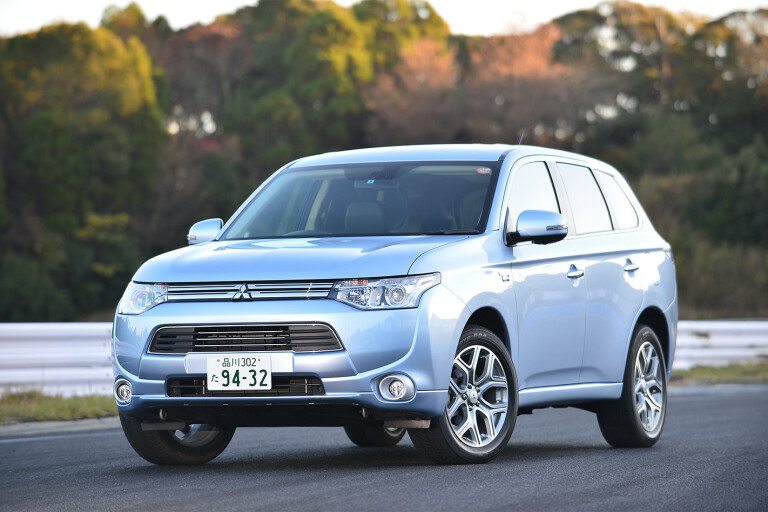
The Outlander PHEV is leading the pack as an affordable battery-powered hybrid.
It’s all-wheel drive, but the connection between the Outlander PHEV’s axles is a big battery, not a rotating shaft. Mitsubishi’s plug-in hybrid has 60kW electric motors at the front and rear, both of which suck from the big lithium-ion power pack installed beneath the floor of its passenger compartment. The petrol-burning 2.0-litre four installed crossways in its engine bay produces 89kW, but its main function is to spin a 70kW generator once the initial battery charge is depleted. Only when the driver presses pedal to the metal, demanding maximum performance, does a wet multiplate clutch engage to connect the engine directly to the front wheels via a single-speed transaxle.
Driving the Outlander PHEV, which will launch in Australia in April, is a foretaste of Mitsubishi’s future. The company is refocusing its research and development energy on SUVs and electric drivetrains. There will be more and more Mitsubishis like the Outlander PHEV.
Already, Mitsubishi is making good progress in one key area – affordability. An engineer with the Outlander PHEV program said the cost of the lithium-ion batteries has been almost halved since the company began producing the i-MiEV in 2009. This little four-seater was the first battery electric car to rack up more than 10,000 global sales despite its high price, and was a valuable learning experience for Mitsubishi. The Outlander PHEV’s 12kW/h battery has three-quarters the energy storage capacity of the i-MiEV’s, but will be relatively affordable. Mitsubishi Australia will offer the Outlander PHEV in two trim grades and is aiming to price them slightly either side of the existing $45,490 Outlander Aspire diesel.
Compared to the Outlander PHEV, the turbo-diesel version is a heavy drinker. The official fuel consumption test result for the plug-in hybrid is just 1.9L/100km, just one-third that of the conventional diesel. The PHEV’s low number takes into account its electric driving range on a full charge. This is 52km, according to the official test regime. The PHEV is limited to 120km/h in electric mode and a recharge will take about five hours using a standard household (240V/10A) power outlet. The five-seat PHEV’s interior space remains practically the same as the standard, with the cargo compartment losing just 14-litres.
Keen to prove the PHEV won’t lack the toughness of the conventional Outlander, Mitsubishi entered one in the Asia Cross Country Rally in 2013. While the suspension was modified for the 2000km event, run mainly in Thailand, the plug-in hybrid drivetrain was left untouched. The competitive stages included muddy and heavily rutted trails, and the Outlander PHEV belted through them without a problem.
Mitsubishi staged a media test drive of the PHEV soon after the 2013 Tokyo Motor Show at the small Mobara Circuit just outside the Japanese capital. It was immediately obvious why the car in the Asia Cross Country Rally needed suspension changes. The soft springs and weak dampers of the standard Japan market suspension mean the PHEV handles like a pig. There’s too much under-steer into corners, too much over-steer if the throttle is lifted mid-corner and the thing rolls like a dinghy in heavy swell. The batteries and underfloor strengthening to protect them mean the PHEV weighs 1810kg, an increase of around 200kg over a turbo diesel AWD Outlander.
But the drivetrain has promise. Although tuned to suit the taste of Japanese pensioners, the pair of electric motors and their four-cylinder generator set work seamlessly.
Acceleration is smoothly sufficient, although the responsiveness could be turned up a notch or three. It is impossible to feel the 2.0-litre engine switching between generator mode, where it is disconnected from the drive wheels, and direct propulsion mode.
With its suspension and plug-in hybrid drivetrain recalibrated for improved handling and snappier response, the Outlander PHEV could easily be the right car to persuade SUV-hungry Australians to give plug-in hybrid tech a try.
MORE: Mitsubishi Outlander Range Review
MORE: Mitsubishi Outlander Specs, Range & Price

COMMENTS